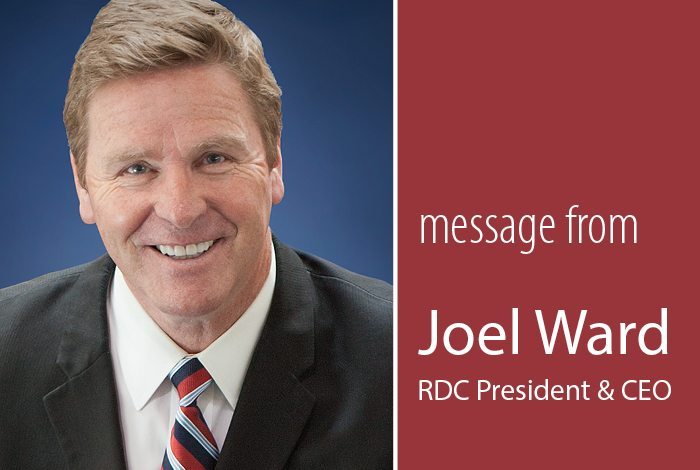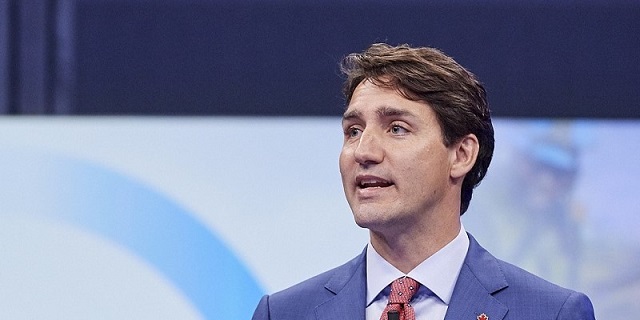Community
Remarkable year at Red Deer College

From RDC President Joel Ward
RDC’s journey through 2018
Of all the important days we celebrated throughout the past year, March 1, 2018, was the single-most historic day for Red Deer College. With 600 people packing our Arts Centre and many more watching through livestream, Premier Rachel Notley shared the long-awaited news that Red Deer College will become a recognized university.
That was the start of our university journey, and this incredible accomplishment was only possible because of the perseverance and commitment of countless people – our senior leaders, staff, faculty, students, partners and community members. This diverse and dedicated group believes in what Red Deer College is and what it can become. As a comprehensive regional teaching university, we will offer the full range of credentials we do now, with the addition of our own degrees. This will benefit our students and strengthen our entire region.
To this end, 2018 saw us achieve many successes in new programming. In May, Minister of Advanced Education, Marlin Schmidt, announced RDC had approval to launch our first four-year degree, a Bachelor of Applied Arts in Animation and Visual Effects. Over several months, we announced other new programs across a range of credentials: a collaborative degree, a diploma, a certificate and three post-diploma certificates. In September, the Minister came to RDC again, when we received approval to launch our second four-year degree, a Bachelor of Applied Arts in Theatre, Film, and Live Entertainment.
This demonstrates our commitment to offering diverse programs across a range of disciplines – programs that our region needs, with courses that have been developed in collaboration with industry professionals. This is exactly the type of university we will become, and I am so proud of the strides we have already made and continue to make as our institution evolves.
Another significant part of our evolution is easy to see with the physical changes on main campus. In August, we celebrated the opening of the Gary W. Harris Canada Games Centre. Since then, students, our RDC Athletics teams, and athletes of all ages from central Alberta and beyond have learned and competed in this building. Community members and organizations have also benefitted from the Fitness Centre and the wealth of opportunities within the facility.
Opportunities for alternative energy learning and research are happening in our new Alternative Energy Lab, which is part of our larger Alternative Energy Initiative. Through this Initiative, we had originally planned on reducing our energy costs by 20%, but we’ve already far surpassed that goal.
We now have almost 4,200 solar panels across campus, which makes RDC an institutional leader across Canada. We’ve also installed a combined heat and power unit, and we’re pursuing other alternative technologies that can convert organic waste into fuel for a boiler system.
Alternative energy technology has also been integrated into our new Residence building, which is in its final stages of construction and will be complete for the 2019 Canada Winter Games.
Throughout all of our initiatives and milestone achievements from the past year, the common thread is the meaningful collaboration with our partners from all areas of this region and beyond. A few highlights that demonstrate this important work include the creation of RDC’s Indigenous Education Strategic Plan, which was led by our Indigenous Student Services team, after extensive consultation with Indigenous communities and Elders, as well as faculty, staff and Indigenous students at RDC.
Another powerful example of collaboration was recently achieved with the Central Alberta Child Advocacy Centre, an important partner with RDC. In December, RDC received Government of Alberta approval for CACAC to build its Centre for Excellence on our campus. This will allow them to expand their services, helping to assist even more children and families in our region, and it will provide many learning opportunities for our students.
2018 has been an incredible year of milestones, and these have had very meaningful impacts for those who learn and work here, as well as those who are connected with our College through partnerships and community support. As we look ahead to 2019, we have an exciting year ahead with RDC’s role in the Canada Winter Games and with the upcoming renaming of our institution. Thank you to our community members, Board of Governors, faculty, staff, students and partners for your support and for working with us to shape RDC’s future.
Joel Ward is President & CEO of Red Deer College.
Community
SPARC Red Deer – Caring Adult Nominations open now!

Red Deer community let’s give a round of applause to the incredible adults shaping the future of our kids. Whether they’re a coach, neighbour, teacher, mentor, instructor, or someone special, we want to know about them!
Tell us the inspiring story of how your nominee is helping kids grow up great. We will honour the first 100 local nominees for their outstanding contributions to youth development. It’s time to highlight those who consistently go above and beyond!
To nominate, visit Events (sparcreddeer.ca)

Addictions
‘Harm Reduction’ is killing B.C.’s addicts. There’s got to be a better way

From the Frontier Centre for Public Policy
B.C. recently decriminalized the possession of small amounts of illicit drugs. The resulting explosion of addicts using drugs in public spaces, including parks and playgrounds, recently led the province’s NDP government to attempt to backtrack on this policy
Fuelled by the deadly manufactured opioid fentanyl, Canada’s national drug overdose rate stood at 19.3 people per 100,000 in 2022, a shockingly high number when compared to the European Union’s rate of just 1.8. But national statistics hide considerable geographic variation. British Columbia and Alberta together account for only a quarter of Canada’s population yet nearly half of all opioid deaths. B.C.’s 2022 death rate of 45.2/100,000 is more than double the national average, with Alberta close behind at 33.3/100,00.
In response to the drug crisis, Canada’s two western-most provinces have taken markedly divergent approaches, and in doing so have created a natural experiment with national implications.
B.C. has emphasized harm reduction, which seeks to eliminate the damaging effects of illicit drugs without actually removing them from the equation. The strategy focuses on creating access to clean drugs and includes such measures as “safe” injection sites, needle exchange programs, crack-pipe giveaways and even drug-dispensing vending machines. The approach goes so far as to distribute drugs like heroin and cocaine free of charge in the hope addicts will no longer be tempted by potentially tainted street drugs and may eventually seek help.
But safe-supply policies create many unexpected consequences. A National Post investigation found, for example, that government-supplied hydromorphone pills handed out to addicts in Vancouver are often re-sold on the street to other addicts. The sellers then use the money to purchase a street drug that provides a better high — namely, fentanyl.
Doubling down on safe supply, B.C. recently decriminalized the possession of small amounts of illicit drugs. The resulting explosion of addicts using drugs in public spaces, including parks and playgrounds, recently led the province’s NDP government to attempt to backtrack on this policy — though for now that effort has been stymied by the courts.
According to Vancouver city councillor Brian Montague, “The stats tell us that harm reduction isn’t working.” In an interview, he calls decriminalization “a disaster” and proposes a policy shift that recognizes the connection between mental illness and addiction. The province, he says, needs “massive numbers of beds in treatment facilities that deal with both addictions and long-term mental health problems (plus) access to free counselling and housing.”
In fact, Montague’s wish is coming true — one province east, in Alberta. Since the United Conservative Party was elected in 2019, Alberta has been transforming its drug addiction policy away from harm reduction and towards publicly-funded treatment and recovery efforts.
Instead of offering safe-injection sites and free drugs, Alberta is building a network of 10 therapeutic communities across the province where patients can stay for up to a year, receiving therapy and medical treatment and developing skills that will enable them to build a life outside the drug culture. All for free. The province’s first two new recovery centres opened last year in Lethbridge and Red Deer. There are currently over 29,000 addiction treatment spaces in the province.
This treatment-based strategy is in large part the work of Marshall Smith, current chief of staff to Alberta’s premier and a former addict himself, whose life story is a testament to the importance of treatment and recovery.
The sharply contrasting policies of B.C. and Alberta allow a comparison of what works and what doesn’t. A first, tentative report card on this natural experiment was produced last year in a study from Stanford University’s network on addiction policy (SNAP). Noting “a lack of policy innovation in B.C.,” where harm reduction has become the dominant policy approach, the report argues that in fact “Alberta is currently experiencing a reduction in key addiction-related harms.” But it concludes that “Canada overall, and B.C. in particular, is not yet showing the progress that the public and those impacted by drug addiction deserve.”
The report is admittedly an early analysis of these two contrasting approaches. Most of Alberta’s recovery homes are still under construction, and B.C.’s decriminalization policy is only a year old. And since the report was published, opioid death rates have inched higher in both provinces.
Still, the early returns do seem to favour Alberta’s approach. That should be regarded as good news. Society certainly has an obligation to try to help drug users. But that duty must involve more than offering addicts free drugs. Addicted people need treatment so they can kick their potentially deadly habit and go on to live healthy, meaningful lives. Dignity comes from a life of purpose and self-control, not a government-funded fix.
Susan Martinuk is a senior fellow at the Frontier Centre for Public Policy and author of the 2021 book Patients at Risk: Exposing Canada’s Health Care Crisis. A longer version of this article recently appeared at C2CJournal.ca.
-

 Business2 days ago
Business2 days agoBusiness investment key to addressing Canada’s productivity crisis
-

 International2 days ago
International2 days agoBrussels NatCon conference will continue freely after court overturns police barricade
-

 Jordan Peterson2 days ago
Jordan Peterson2 days agoJordan Peterson slams CBC for only interviewing pro-LGBT doctors about UK report on child ‘sex changes’
-

 Business2 days ago
Business2 days agoFederal budget fails to ‘break the glass’ on Canada’s economic growth crisis
-

 Alberta1 day ago
Alberta1 day agoDanielle Smith warns arsonists who start wildfires in Alberta that they will be held accountable
-

 Addictions2 days ago
Addictions2 days agoLiberal MP blasts Trudeau-backed ‘safe supply’ drug programs, linking them to ‘chaos’ in cities
-

 Frontier Centre for Public Policy2 days ago
Frontier Centre for Public Policy2 days agoThe Smallwood solution
-

 Agriculture1 day ago
Agriculture1 day agoBill C-282, now in the Senate, risks holding back other economic sectors and further burdening consumers






